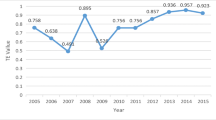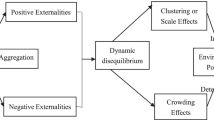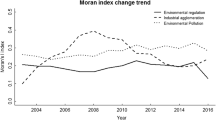Abstract
In this paper, we set a two region two sector two factor model under a new economic geography (NEG) framework, and in this model, the manufacturing sector is divided into two industries, high pollution and low pollution industries.We discussed effects of environmental policy differences on the regional distribution of the manufacturing sector and structural change of industries in each region. We found that on one hand, the structural changes of industries are very sensitive to the environmental policy differences, while on the other hand, the regional distribution of the manufacturing sector is not as sensitive, which provided a reasonable explanation for China’s “Pollution moving westward, production moving eastward” phenomenon. And we also found that it is improper to appeal manufacturing firms by relaxing the environmental policy, even regardless of the externality arising from environmental pollution. It not only attracts the “dirty industry”, but also repels the “clean industry”, and almost has no effect on share of manufacturing output.
Access this chapter
Tax calculation will be finalised at checkout
Purchases are for personal use only
Preview
Unable to display preview. Download preview PDF.
Similar content being viewed by others

References
Baldwin R, Forslid R, Martin P et al. (2003) Economic geography and public policy. 1st edn, Princeton University Press, Princeton.
Chamberlin EH (1993) The theory of monopolistic competition. 1st edn, Harvard University Press, Boston.
Li J (2010) A chance maximization portfolio selection model in fuzzy random environment. In: Proceedings of the Fourth International Conference on Management Science and Engineering Management.
Fujita M, Krugman P, Mori T (1999) On the evolution of hierarchical urban systems. European Economic Review 43:209–251.
Fujita M, Krugman P, Venables A (1999) The spatial economy: Cities, regions, and international trade. 1st edn, MIT Press, Boston.
Krugman P (1980) Scale economies, product differentiation, and the pattern of trade. American Economic Review 70:950–959.
Martin P, Rogers CA (1995) Industrial location and public infrastructure. Journal of International Economics 39:335–351.
Takatsuka H, Zeng D (2009) Dispersion forms: An interaction of market access, competition, and urban costs. Journal of Regional Science 49:177–204.
Walter I (1973) The pollution content of American trade. Western Economic Journal 11:61–70.
Zeng D (2008) New economic geography with heterogeneous preferences: An explanation of segregation. Journal of Urban Economics 63:306–324.
Zeng D (2006) Redispersion is different from dispersion: Spatial economy of multiple industries. Annals of Regional Science 40:229–247.
Zhang L, Yuan Y (2010) A POS-based algorithm for airline crew scheduling problem under uncertainty environment. In: Proceedings of the Fourth International Conference on Management Science and Engineering Management.
Peng H, Ren R (2003) The environmental policy tool and corperate competitive advantage. China Industrial Economy 89–95 (In Chinses).
Yang Y (2008) The comparative study to the eastern and western regions transfer of pollutionintensive industries in China. Ecological Economy 133–147 (In Chinses).
Luo H, Wang J, Cao D (2000) Environmental challenge and countermeasures for Great Western Region Development in China. Reasearch of Environmental Sciences 110–127 (In Chinses) 86 Aggregate Effect and Structural Effect of Environmental Policy 1007.
Su Y (2005) Very bad and very good-the disadvantages and advantages fo western development of high energy consumption high pollution industry. Northern Economy 237-251 (In Chinses).
Tang Y, Xiong X,Wei Y (2009) A study on operational stratey and innovation of implementation model for environment protection in business. In: Proceedings of the Third International Conference on Management Science and Engineering Management.
Author information
Authors and Affiliations
Corresponding author
Editor information
Editors and Affiliations
Rights and permissions
Copyright information
© 2013 Springer-Verlag London
About this paper
Cite this paper
Tan, L. (2013). Aggregate Effect and Structural Effect of Environmental Policy Differences in China. In: Xu, J., Yasinzai, M., Lev, B. (eds) Proceedings of the Sixth International Conference on Management Science and Engineering Management. Lecture Notes in Electrical Engineering, vol 185. Springer, London. https://doi.org/10.1007/978-1-4471-4600-1_86
Download citation
DOI: https://doi.org/10.1007/978-1-4471-4600-1_86
Published:
Publisher Name: Springer, London
Print ISBN: 978-1-4471-4599-8
Online ISBN: 978-1-4471-4600-1
eBook Packages: EngineeringEngineering (R0)



